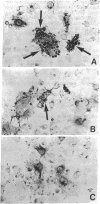Abstract
CD4, a cell surface glycoprotein expressed primarily by T lymphocytes and monocytes, interacts with HLA class II antigens to regulate the immune response. In AIDS, CD4 is the receptor for the human immunodeficiency virus, which binds to CD4 through envelope glycoprotein gp120. Delineation of the ligand-binding sites of CD4 is necessary for the development of immunomodulators and antiviral agents. Although the gp120 binding site has been characterized in detail, much less is known about the class II binding site, and it is as yet uncertain whether they partially or fully overlap. To investigate CD4 binding sites, a cellular adhesion assay between COS cells transiently transfected with CD4 and B lymphocytes expressing HLA class II antigens has been developed that is strictly dependent on the CD4--class II interaction, quantitative, and highly reproducible. Mutants of CD4 expressing amino acids with distinct physicochemical properties at positions Arg-54, Ala-55, Asp-56, and Ser-57 in V1, the first extracellular immunoglobulin-like domain, have been generated and studied qualitatively and quantitatively for interaction with HLA class II antigens, for membrane expression, for the integrity of CD4 epitopes recognized by a panel of monoclonal antibodies, and for gp120 binding. The results obtained show that the mutations in this tetrapeptide, which forms the core of a synthetic peptide previously shown to have immunosuppressive properties, affect the two binding functions of CD4 similarly, lending support to the hypothesis that the human immunodeficiency virus mimicks HLA class II binding to CD4.
Full text
PDF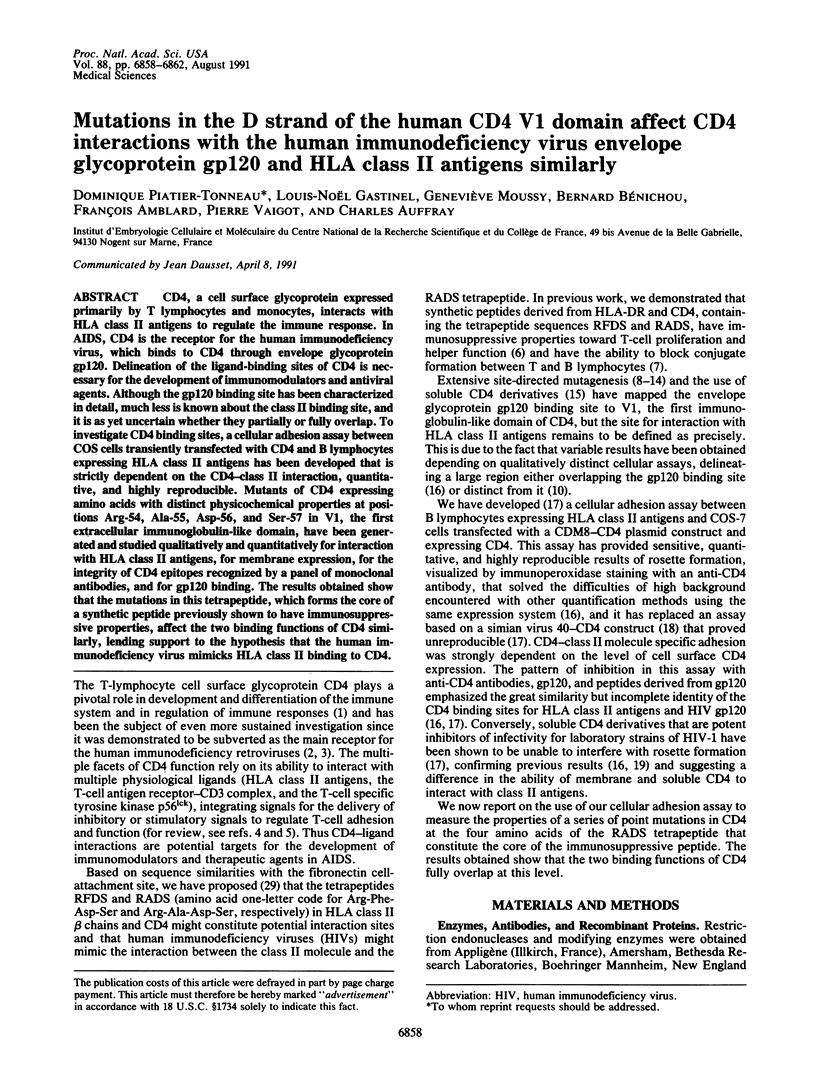
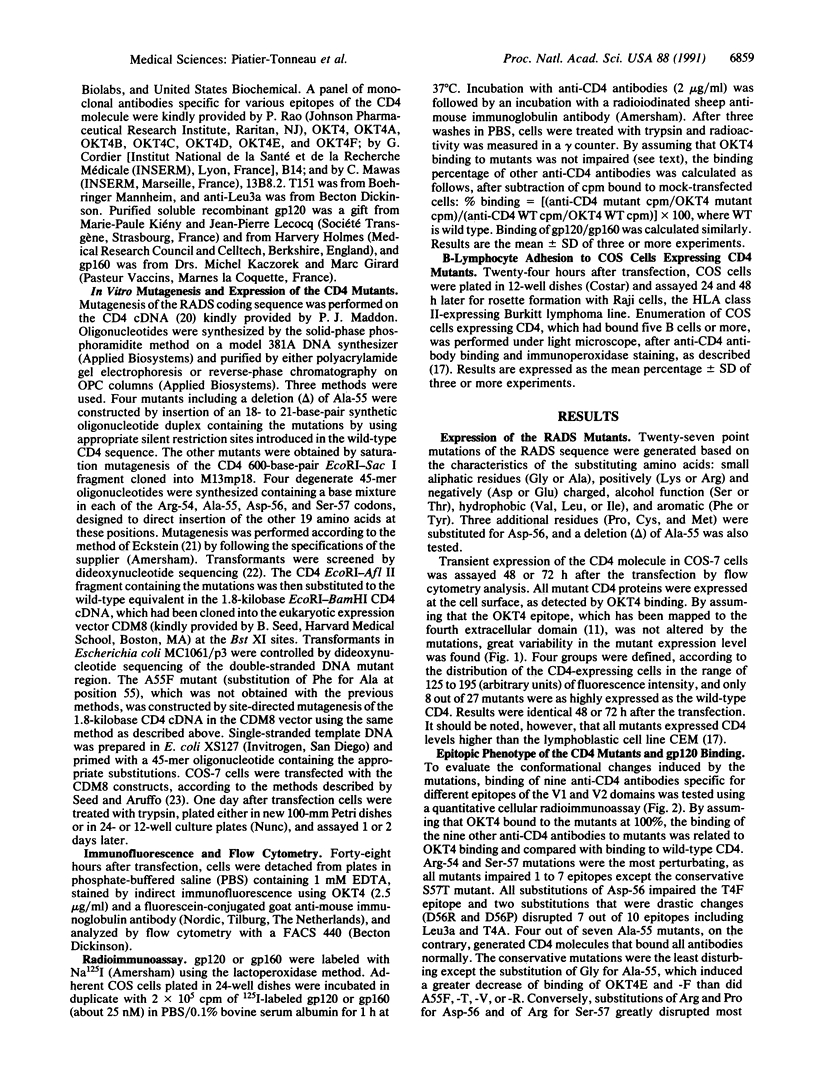
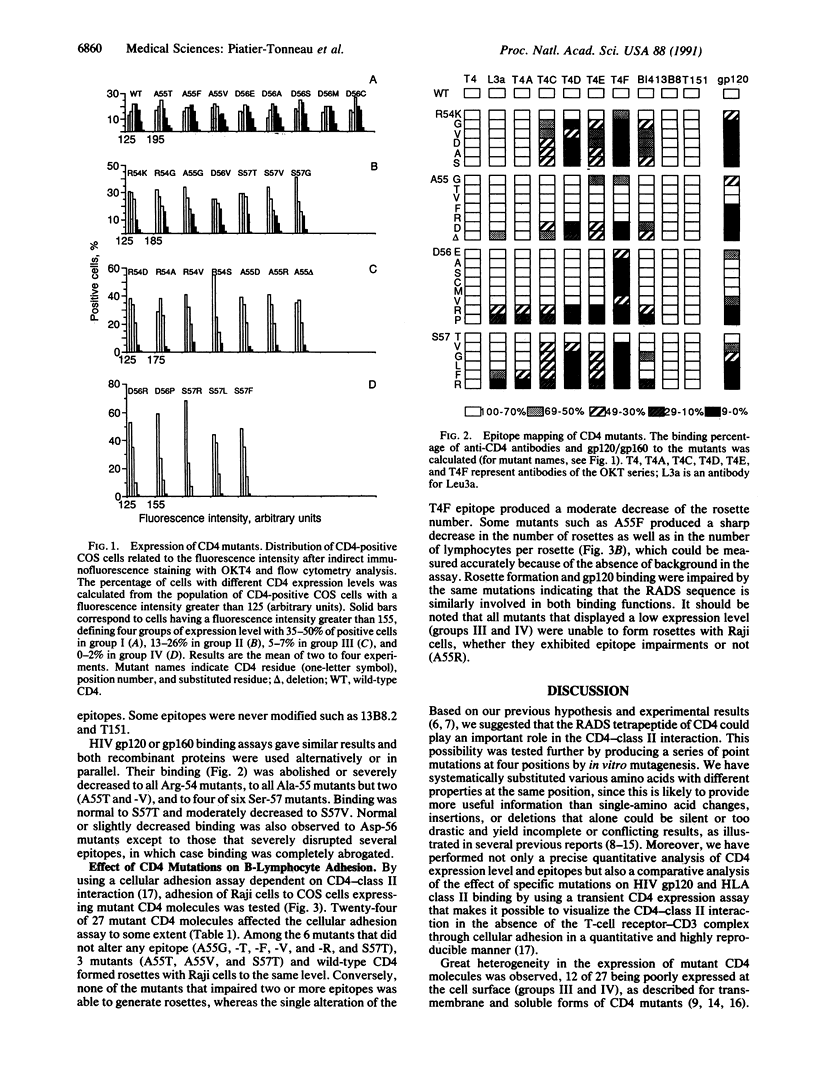
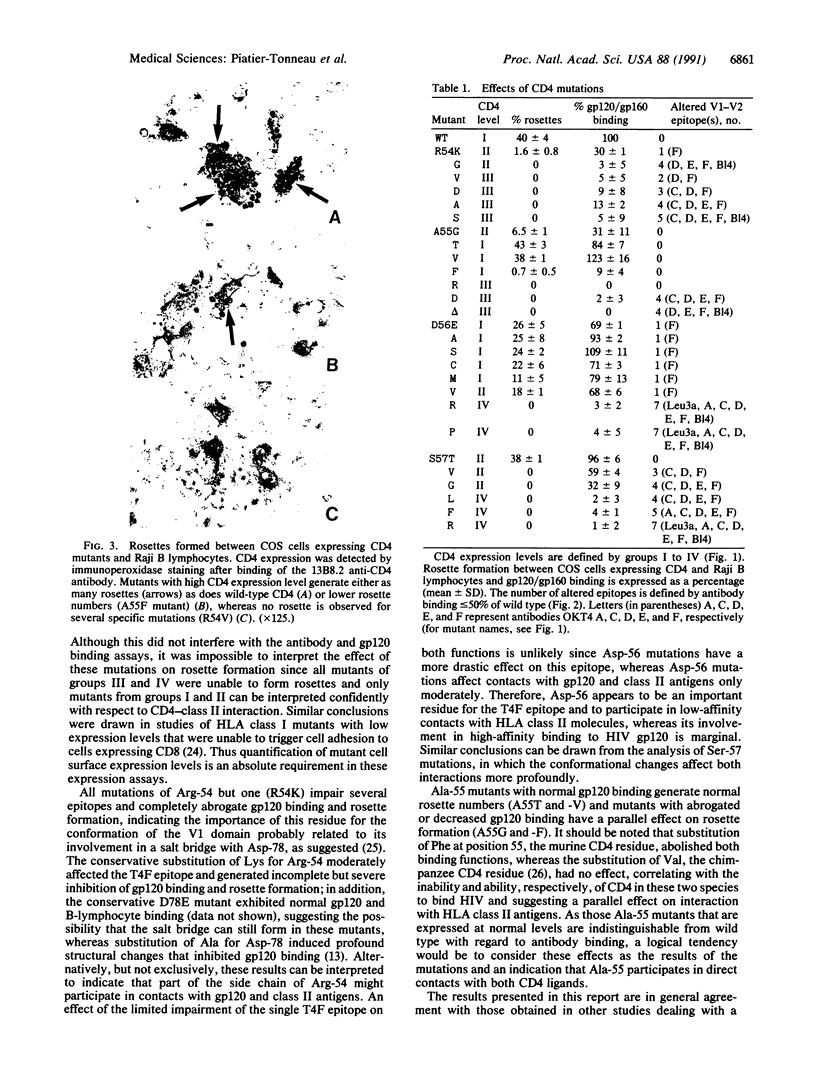
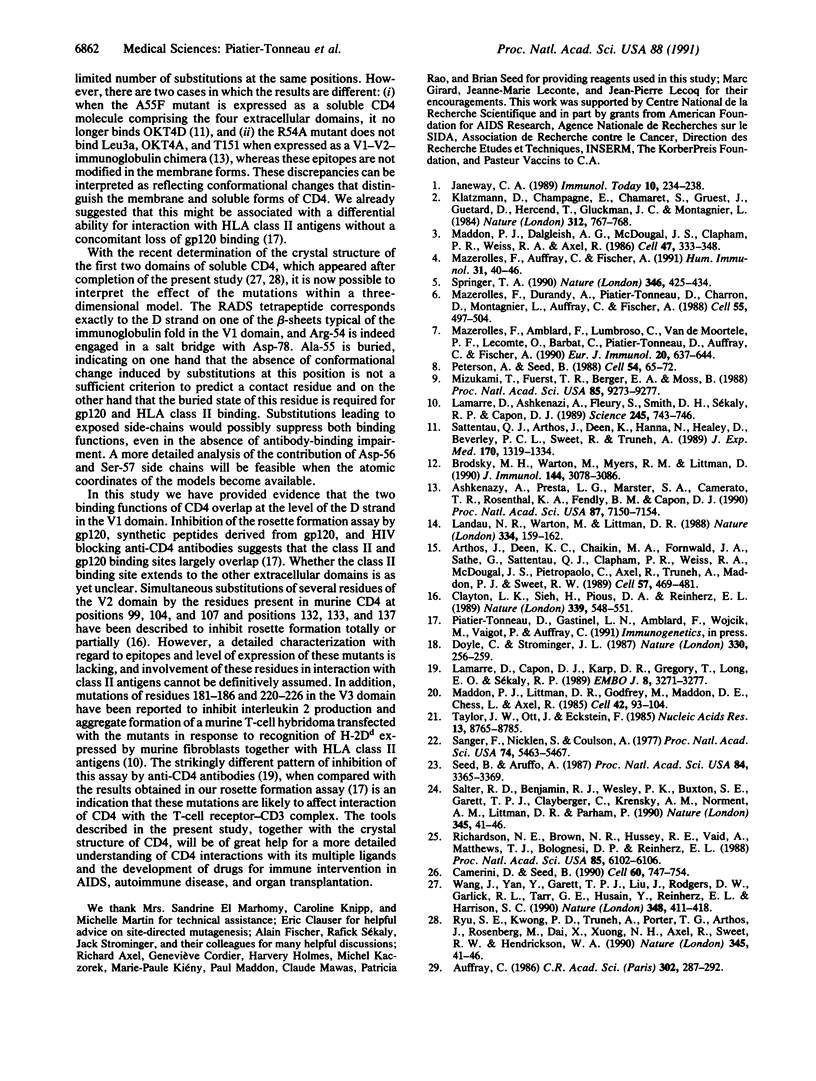
Images in this article
Selected References
These references are in PubMed. This may not be the complete list of references from this article.
- Arthos J., Deen K. C., Chaikin M. A., Fornwald J. A., Sathe G., Sattentau Q. J., Clapham P. R., Weiss R. A., McDougal J. S., Pietropaolo C. Identification of the residues in human CD4 critical for the binding of HIV. Cell. 1989 May 5;57(3):469–481. doi: 10.1016/0092-8674(89)90922-7. [DOI] [PubMed] [Google Scholar]
- Ashkenazi A., Presta L. G., Marsters S. A., Camerato T. R., Rosenthal K. A., Fendly B. M., Capon D. J. Mapping the CD4 binding site for human immunodeficiency virus by alanine-scanning mutagenesis. Proc Natl Acad Sci U S A. 1990 Sep;87(18):7150–7154. doi: 10.1073/pnas.87.18.7150. [DOI] [PMC free article] [PubMed] [Google Scholar]
- Auffray C. Un modèle moléculaire de l'interaction entre l'antigène T4 et les antigènes HLA de classe II ou le virus LAV. C R Acad Sci III. 1986;302(8):287–292. [PubMed] [Google Scholar]
- Brodsky M. H., Warton M., Myers R. M., Littman D. R. Analysis of the site in CD4 that binds to the HIV envelope glycoprotein. J Immunol. 1990 Apr 15;144(8):3078–3086. [PubMed] [Google Scholar]
- Camerini D., Seed B. A CD4 domain important for HIV-mediated syncytium formation lies outside the virus binding site. Cell. 1990 Mar 9;60(5):747–754. doi: 10.1016/0092-8674(90)90089-w. [DOI] [PubMed] [Google Scholar]
- Clayton L. K., Sieh M., Pious D. A., Reinherz E. L. Identification of human CD4 residues affecting class II MHC versus HIV-1 gp120 binding. Nature. 1989 Jun 15;339(6225):548–551. doi: 10.1038/339548a0. [DOI] [PubMed] [Google Scholar]
- Doyle C., Strominger J. L. Interaction between CD4 and class II MHC molecules mediates cell adhesion. Nature. 1987 Nov 19;330(6145):256–259. doi: 10.1038/330256a0. [DOI] [PubMed] [Google Scholar]
- Janeway C. A., Jr The role of CD4 in T-cell activation: accessory molecule or co-receptor? Immunol Today. 1989 Jul;10(7):234–238. doi: 10.1016/0167-5699(89)90260-0. [DOI] [PubMed] [Google Scholar]
- Klatzmann D., Champagne E., Chamaret S., Gruest J., Guetard D., Hercend T., Gluckman J. C., Montagnier L. T-lymphocyte T4 molecule behaves as the receptor for human retrovirus LAV. Nature. 1984 Dec 20;312(5996):767–768. doi: 10.1038/312767a0. [DOI] [PubMed] [Google Scholar]
- Lamarre D., Ashkenazi A., Fleury S., Smith D. H., Sekaly R. P., Capon D. J. The MHC-binding and gp120-binding functions of CD4 are separable. Science. 1989 Aug 18;245(4919):743–746. doi: 10.1126/science.2549633. [DOI] [PubMed] [Google Scholar]
- Lamarre D., Capon D. J., Karp D. R., Gregory T., Long E. O., Sékaly R. P. Class II MHC molecules and the HIV gp 120 envelope protein interact with functionally distinct regions of the CD4 molecule. EMBO J. 1989 Nov;8(11):3271–3277. doi: 10.1002/j.1460-2075.1989.tb08487.x. [DOI] [PMC free article] [PubMed] [Google Scholar]
- Landau N. R., Warton M., Littman D. R. The envelope glycoprotein of the human immunodeficiency virus binds to the immunoglobulin-like domain of CD4. Nature. 1988 Jul 14;334(6178):159–162. doi: 10.1038/334159a0. [DOI] [PubMed] [Google Scholar]
- Maddon P. J., Dalgleish A. G., McDougal J. S., Clapham P. R., Weiss R. A., Axel R. The T4 gene encodes the AIDS virus receptor and is expressed in the immune system and the brain. Cell. 1986 Nov 7;47(3):333–348. doi: 10.1016/0092-8674(86)90590-8. [DOI] [PubMed] [Google Scholar]
- Maddon P. J., Littman D. R., Godfrey M., Maddon D. E., Chess L., Axel R. The isolation and nucleotide sequence of a cDNA encoding the T cell surface protein T4: a new member of the immunoglobulin gene family. Cell. 1985 Aug;42(1):93–104. doi: 10.1016/s0092-8674(85)80105-7. [DOI] [PubMed] [Google Scholar]
- Mazerolles F., Amblard F., Lumbroso C., Lecomte O., Van de Moortele P. F., Barbat C., Piatier-Tonneau D., Auffray C., Fischer A. Regulation of T helper-B lymphocyte adhesion through CD4-HLA class II interaction. Eur J Immunol. 1990 Mar;20(3):637–644. doi: 10.1002/eji.1830200326. [DOI] [PubMed] [Google Scholar]
- Mazerolles F., Auffray C., Fischer A. Down regulation of T-cell adhesion by CD4. Hum Immunol. 1991 May;31(1):40–46. doi: 10.1016/0198-8859(91)90047-d. [DOI] [PubMed] [Google Scholar]
- Mazerolles F., Durandy A., Piatier-Tonneau D., Charron D., Montagnier L., Auffray C., Fischer A. Immunosuppressive properties of synthetic peptides derived from CD4 and HLA-DR antigens. Cell. 1988 Nov 4;55(3):497–504. doi: 10.1016/0092-8674(88)90036-0. [DOI] [PubMed] [Google Scholar]
- Mizukami T., Fuerst T. R., Berger E. A., Moss B. Binding region for human immunodeficiency virus (HIV) and epitopes for HIV-blocking monoclonal antibodies of the CD4 molecule defined by site-directed mutagenesis. Proc Natl Acad Sci U S A. 1988 Dec;85(23):9273–9277. doi: 10.1073/pnas.85.23.9273. [DOI] [PMC free article] [PubMed] [Google Scholar]
- Peterson A., Seed B. Genetic analysis of monoclonal antibody and HIV binding sites on the human lymphocyte antigen CD4. Cell. 1988 Jul 1;54(1):65–72. doi: 10.1016/0092-8674(88)90180-8. [DOI] [PubMed] [Google Scholar]
- Richardson N. E., Brown N. R., Hussey R. E., Vaid A., Matthews T. J., Bolognesi D. P., Reinherz E. L. Binding site for human immunodeficiency virus coat protein gp120 is located in the NH2-terminal region of T4 (CD4) and requires the intact variable-region-like domain. Proc Natl Acad Sci U S A. 1988 Aug;85(16):6102–6106. doi: 10.1073/pnas.85.16.6102. [DOI] [PMC free article] [PubMed] [Google Scholar]
- Salter R. D., Benjamin R. J., Wesley P. K., Buxton S. E., Garrett T. P., Clayberger C., Krensky A. M., Norment A. M., Littman D. R., Parham P. A binding site for the T-cell co-receptor CD8 on the alpha 3 domain of HLA-A2. Nature. 1990 May 3;345(6270):41–46. doi: 10.1038/345041a0. [DOI] [PubMed] [Google Scholar]
- Salter R. D., Benjamin R. J., Wesley P. K., Buxton S. E., Garrett T. P., Clayberger C., Krensky A. M., Norment A. M., Littman D. R., Parham P. A binding site for the T-cell co-receptor CD8 on the alpha 3 domain of HLA-A2. Nature. 1990 May 3;345(6270):41–46. doi: 10.1038/345041a0. [DOI] [PubMed] [Google Scholar]
- Sanger F., Nicklen S., Coulson A. R. DNA sequencing with chain-terminating inhibitors. Proc Natl Acad Sci U S A. 1977 Dec;74(12):5463–5467. doi: 10.1073/pnas.74.12.5463. [DOI] [PMC free article] [PubMed] [Google Scholar]
- Sattentau Q. J., Arthos J., Deen K., Hanna N., Healey D., Beverley P. C., Sweet R., Truneh A. Structural analysis of the human immunodeficiency virus-binding domain of CD4. Epitope mapping with site-directed mutants and anti-idiotypes. J Exp Med. 1989 Oct 1;170(4):1319–1334. doi: 10.1084/jem.170.4.1319. [DOI] [PMC free article] [PubMed] [Google Scholar]
- Seed B., Aruffo A. Molecular cloning of the CD2 antigen, the T-cell erythrocyte receptor, by a rapid immunoselection procedure. Proc Natl Acad Sci U S A. 1987 May;84(10):3365–3369. doi: 10.1073/pnas.84.10.3365. [DOI] [PMC free article] [PubMed] [Google Scholar]
- Springer T. A. Adhesion receptors of the immune system. Nature. 1990 Aug 2;346(6283):425–434. doi: 10.1038/346425a0. [DOI] [PubMed] [Google Scholar]
- Taylor J. W., Ott J., Eckstein F. The rapid generation of oligonucleotide-directed mutations at high frequency using phosphorothioate-modified DNA. Nucleic Acids Res. 1985 Dec 20;13(24):8765–8785. doi: 10.1093/nar/13.24.8765. [DOI] [PMC free article] [PubMed] [Google Scholar]
- Wang J. H., Yan Y. W., Garrett T. P., Liu J. H., Rodgers D. W., Garlick R. L., Tarr G. E., Husain Y., Reinherz E. L., Harrison S. C. Atomic structure of a fragment of human CD4 containing two immunoglobulin-like domains. Nature. 1990 Nov 29;348(6300):411–418. doi: 10.1038/348411a0. [DOI] [PubMed] [Google Scholar]



